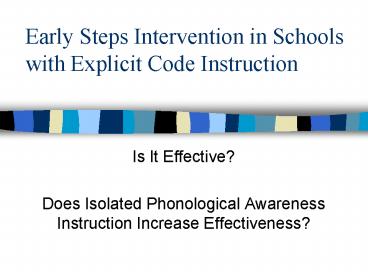Early Steps Intervention in Schools with Explicit Code Instruction - PowerPoint PPT Presentation
Title:
Early Steps Intervention in Schools with Explicit Code Instruction
Description:
Early Steps Intervention in Schools with Explicit Code Instruction Is It Effective? Does Isolated Phonological Awareness Instruction Increase Effectiveness? – PowerPoint PPT presentation
Number of Views:147
Avg rating:3.0/5.0
Title: Early Steps Intervention in Schools with Explicit Code Instruction
1
Early Steps Intervention in Schools with Explicit
Code Instruction
- Is It Effective?
- Does Isolated Phonological Awareness Instruction
Increase Effectiveness?
2
University of Utah Granite School District
Salt Lake City, UT
- Kathleen J. Brown, Veronica Reynolds, Stacey
Lowe, Debbie Skidmore, - Debbie Van Gorder, Sue Patillo,
- Connie Weinstein, Julie World,
- Amy Morris
3
Theoretical Framework
- Early Steps
- repeated reading _at_ instructional level
- systematic, isolated code instruction
- writing-embedded PA instruction
- Early Steps effective for at-risk in G1
embedded or implicit code classrooms
(Morris, 1999 Morris, Tyner, Perney, in press
Santa Hoien, 1999
4
Theoretical Framework
- Phonological Awareness (PA) is causally related
to early reading success - PA instruction important part of effective
intervention
(Bradley Bryant, 1983 Perfetti, Beck, Bell,
Hughes, 1987 Tunmer, Nesdale, Harriman,1988)
5
Research Question
Is Early Steps effective for at-risk G1 students
whose classroom instruction provides - sys.
exp. decoding - sys. exp. PA - literature
decodable texts - spelling dictation, and -
writing workshop?
6
Research Question
Once students are aware of initial
phonemes, Does isolated PA instruction make Early
Steps more effective? - Early Steps
writing-embedded PAI listening for sounds in
sentence writing - isolated PAI (strictly oral
activities, no text involved)
7
Method
- Students 31 ethnic minority 46 free
lunch 18 ESL - Tutors G1 teachers, RS in training, grad
students, Title I aides - Sept. 99-May 00
8
Method Intervention Study
- At-risk G1 students identified by scores on
- alphabet knowledge
- phonological awareness via spelling task
- Control group identified by matching baseline
scores with tx group
Morris, 1992
9
Method Intervention Study
- N88 G1 students from 7 Title 1 schools
- Early Steps Intervention
- 30 min. daily, 1-on-1
- Title I Intervention
- 30-45 min. daily, small group
- reinforce Open Court
10
Method PAI study
- Identified Early Steps students with moderate
alphabet knowledge and low PA - matched on baseline scores
- random assignment to conditions
11
Method PAI study
- N24 Early Steps students
- Embedded Isolated PA Instruction
- writing-embedded PA
- PA isolated in oral activities
- PA Control
- writing-embedded PA only
12
Results Intervention Study
a 73rd percentile b 54th percentile c
47th percentile d 27th percentile
13
Results PAI Study
14
Discussion
- Early Steps benefits at-risk G1 students
receiving explicit code instruction as measured
by - passage reading
- word attack
- comprehension
- spelling
15
Discussion
- Once Early Steps students are aware of initial
phonemes, adding isolated PAI does not improve
effectiveness - listening for sounds during daily sentence
writing may be sufficient






























